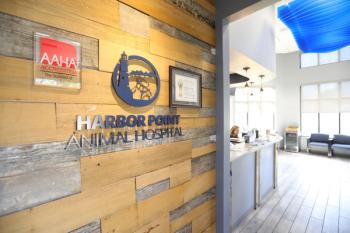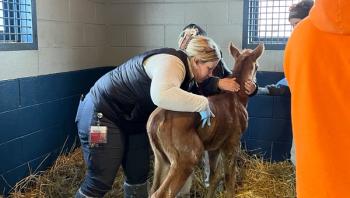
AVMA delegates to debate veterinarian's oath, foreign graduates
Schaumburg, Ill. - Changes to the Veterinarian's Oath, made last fall by the American Veterinary Medical Association's (AVMA) Executive Board without input from the House of Delegates (HOD), have spurred three proposed bylaw amendments from member veterinary associations.
SCHAUMBURG, ILL. — Changes to the Veterinarian's Oath, made last fall by the American Veterinary Medical Association's (AVMA) Executive Board without input from the House of Delegates (HOD), have spurred three proposed bylaw amendments from member veterinary associations.
The revised Veterinarian's Oath now makes reference to the veterinarian's role in animal welfare matters—phrasing previously left out of the oath.
AVMA says "some HOD members reacted with concern that the board could revise the oath, despite the HOD being, as stated in the bylaws, "the principal body within the association responsible for establishing policy and providing direction for matters relating to veterinary medicine."
As a result, numerous veterinary medical associations have come forward with three bylaw amendments to be considered by HOD when it gathers for its regular annual session July 14 to 15.
Amendments
The first, Amendment 10, addresses the authority and responsibilities of the House of Delegates and was submitted by veterinary medical associations from Puerto Rico, Vermont, North Carolina, Pennsylvania, Louisiana, New Hampshire, Arkansas, Florida, Connecticut and Mississippi. The amendment states that as the policy-making body of AVMA that authored the original oath, HOD should be responsible for approving any changes made to the guiding document.
"The Veterinarian's Oath is a powerful, concise statement expressing the commitment of all graduating U.S. veterinarians upon entering the veterinary profession ... The House of Delegates authored the original oath and should be the body to approve any future revisions," the amendment states. "The Veterinarian's Oath should reflect our lifetime commitment as one of the health professions and any revisions should only be undertaken with an approval vote by the HOD."
Amendment 11 also concerns the powers of the HOD. The Utah Veterinary Medical Association submitted the amendment and asks that the Executive Board be required to consult with the HOD on "any matters relating to veterinary medicine" before changing policies. Previously, the Executive Board was directed to act on behalf of HOD between sessions.
"The HOD should receive and consider all major policy changes that concern the practice of veterinary medicine, and especially those that affect the day-to-day practice of our constituents and the oaths they take," the amendment states.
Amendment 12 also brings up authority matters. The Connecticut Veterinary Medical Association is asking that any policy changes made by the Executive Board between HOD sessions be considered "interim" policies until the next HOD meeting.
"There have been several instances over the last five years that the House of Delegates felt that it was left out of policy decisions regarding matters of veterinary medicine," the amendment states. "This bylaws change would allow the House of Delegates to comment on those recommendations to the Executive Board prior to ratification, rather than being upset after ratification."
Other amendments that will be considered at the HOD meeting include:
- Amendment 2 would alter the organization of the Council on Public Health and Regulatory Veterinary Medicine. The Council would provide expert advice and consultation on issues involving public health, make recommendations about preventive medicine and public practice, and work collaboratively with other AVMA entities to respond to emerging issues. The aim of the amendment is to make the council more relevant and proactive, and it's recommended for adoption by both the Executive Board and the House Advisory Committee.
- Amendment 3 calls for a change in the role of AVMA president and president-elect, inviting each to participate in all groups that report to the Executive Board, aside from the Judicial Council. Current language has them working with "all councils." The change would allow the president and president-elect to participate in groups other than councils, like task forces and committees. The amendment is recommended for approval by the Executive Board and the House Advisory Committee.
- Amendment 4 also involves the role of AVMA president and vice president, adding the Council on Education as an exemption to their participation, along with the Judicial Council. The move reflects "best practices" for an accrediting agency, according to the amendment, which is recommended for approval by the Executive Board and the House Advisory Committee.
- Amendment 5 removes "in the event of death, resignation, removal or incapacity of the president," the AVMA vice president would assume the presidency, replacing it simply with phrasing that allows the vice president to take over the position in the event of a vacancy in the office of the president. The amendment is recommended for approval by the Executive Board and the House Advisory Committee.
- Amendment 6, recommended for approval by the Executive Board and the House Advisory Committee, proposes that when the outgoing AVMA president is unable to fulfill the position of immediate past president, the serving immediate past president would serve another term.
- Amendment 7 would address the issue of a vacancy in the office of the president-elect, allowing the Executive Board to fill the third position on the Board of Governors from its own membership in the event of a president-elect vacancy. The amendment is recommended for approval by the Executive Board and the House Advisory Committee.
- Amendment 8 changes language for AVMA's membership categories, adding "is a diplomate in good standing of the AVMA/Board of Veterinary Specialties (ABVS) recognized veterinary specialty organization" to one of the qualifiers of becoming a voting member of the organization. The addition would "balance the desire for the AVMA to remain an inclusive organization, yet maintain the high value of its membership," according to the amendment. The amendment is recommended for approval by the Executive Board and the House Advisory Committee.
- Amendment 9 clarifies AVMA's grounds for discipline. Submitted by the Executive Board and recommended for approval by the Executive Board and the House Advisory Committee, the amendment would replace "conviction" with "having been found guilty" to avoid confusion about whether an individual was convicted under applicable laws. It replaces "forfeiture" with "other disciplinary action" in terms of licensing, because forfeiture is a voluntary act by an individual rather than a licensing authority, according to the amendment. Finally, "immoral, dishonorable, or unprofessional" conduct now is defined as "other," since the original terms were "vague and subject to varied interpretations."
Resolutions
In addition to the bylaw amendments, HOD also will consider three resolutions, with the dominant theme aimed at giving members more input on AVMA matters.
Resolution 6, submitted to the HOD by the Arizona and California veterinary medical associations, questions AVMA's globalization efforts, asking the HOD to direct the Executive Board to analyze the association's international activities through a task force. The task force, with half the members recommended to the Executive Board by the House Advisory Committee, would investigate how much of AVMA's current resources are directed toward international affairs, and whether AVMA's membership would prefer that more of those resources be put to domestic issues.
Resolution 5, submitted by veterinary medical associations from Arkansas, California, Montana, New Mexico, Oklahoma, Texas and Utah, it asks that a task force perform a peer review of foreign veterinary school accreditation. The review would address the impact of the Council on Education (COE) on the economic viability of the veterinary profession, veterinary workforce and the quality of standards for the veterinary profession in the United States. The associations submitting the resolution also ask that the task force be created from the general AVMA membership, with a variety of backgrounds represented.
"The recent accreditation of two foreign schools and other foreign schools requesting accreditation site visits raise concerns regarding an influx of foreign veterinary graduates who are no longer required to follow required routes to licensure through the ECFVG or PAVE," the resolution states. "It is vital to ensure member confidence that the AVMA policy on accrediting foreign schools be openly reviewed by representative members of AVMA constituencies, not necessarily participants in formal AVMA government entities."
Over the last 70 years, a total of 16 foreign veterinary schools have been accredited by AVMA's COE, the resolution notes, with 11 in the last 13 years alone. The associations want the task force to look into possible adverse effects on the domestic veterinary profession and workforce should foreign accreditation continue along the same path. What does accreditation of foreign veterinary schools do for the American public and AVMA's membership? the resolution asks. Additionally, the task force is asked to look into the logistics and expense, as well as any international pressure, AVMA's COE faces during the accreditation process.
Finally, Resolution 4, submitted to the HOD by the Executive Board, suggests changes to the way veterinary facilities are named to create more consistency and clarity to the public.
The new definitions separate hospitals, clinics and centers, as well as specialty and referral facilities. Definitions for outpatient clinics and on-call emergency services have been added.
The resolution is recommended for approval by both the Executive Board and the House Advisory Committee.
Newsletter
From exam room tips to practice management insights, get trusted veterinary news delivered straight to your inbox—subscribe to dvm360.




